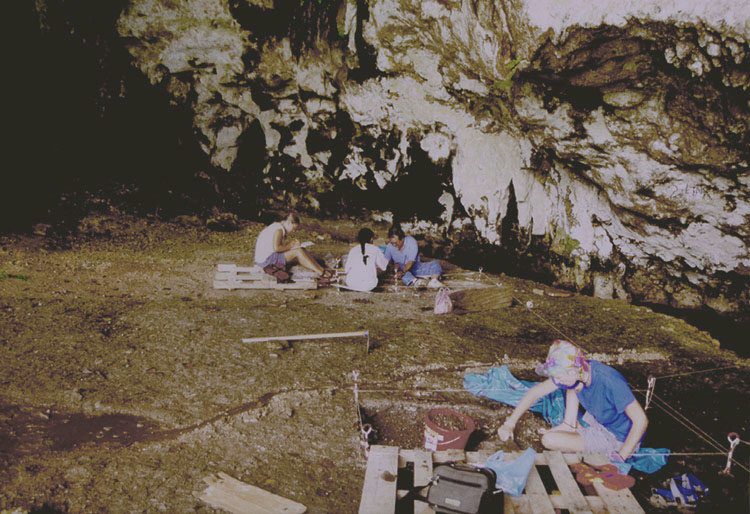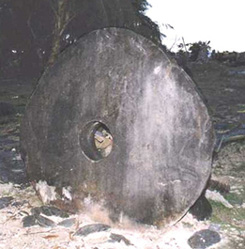
|
| Omis Cave test excavation in progress |
Archaeological research in Palau has had a relatively long history for Micronesia; it began with Hisakatsu's work in 1929 (Hisakatsu 1997) and continued with Osborne's research from the mid-1950s to the late 1960s (Osborne 1979). Numerous other archaeological investigations have been carried out in the past 30 years, especially by researchers from Japan and the U.S., significantly contributing to what we now know of Palauan prehistoric and historic archaeology. A research and teaching relationship between the Palau Division of Cultural Affairs (DCA; also known as the Historic Preservation Program) and Southern Illinois University in the 1980s also had a major impact in increasing knowledge of Palauan archaeology and ethnography (Gumerman et al. 1980). More recently, much of the archaeological work has been done by the HPO staff or private contractors hired to do reconnaissance and semi-intensive investigations for larger infrastructure projects such as the Rural Water System (Beardsley 1996), the Palau National Communications Corporation fiber optic lines (Wickler 1996), and the Babeldaob Compact Road (Wickler 1994).
A lack of financial resources, time, and other commitments has limited Palauan involvement with the actual fieldwork done by other archaeologists. With some recent changes in office personnel, increasing permit requests for development projects, and the need to complete its own 3-year plan for archaeological site inventory, the HPO Archaeology and Survey staff needed to upgrade field techniques related to archaeological mapping, surveying, and site recording. A training project undertaken by the University of Oregon has helped remedy this situation. With financial help from the Sasakawa Foundation and the East-West Center, Honolulu, we set out to conduct training projects that were both informative and useful, focusing on the fundamental skills required for producing maps and effectively surveying archaeological sites. The organization of this project also fit into the long-range goals of the 5-year plan developed by Fitzpatrick and Kanai (1997) for the DCA in forming cooperative relationships with other researchers and universities.
Project Aims
The basic purpose of these projects was to help develop field archaeology skills useful
for historic preservation and cultural resource management and at the same time to provide new
archaeological data on the prehistory of Palau.
The specific aim was to provide assistance for training employees in the Palau government
whose responsibilities include developing archaeological site inventories and records, conserving historic and traditional cultural sites, and
approving permits. Historic Preservation officers and staff participated in the training component.
Acknowlegements
The training projects have been supported by the Sasakawa Foundation, Japan, the East-West
Center's Pacific Islands Development Program, Hawaii, and the University of Oregon and was
coordinated with Dr. Yosihiko Sinoto, Bernice P. Bishop Museum, Hawaii. Ms. Victoria N. Kanai,
the Chief of the Historic Preservation Office in the Division of Cultural Affairs, was the key
administrator for Palau.
The Palau participants included: Ms. Rita Olsudong, MA, Staff Archaeologist for the
Palau HPO; Mr. Florencio Gibbons, Palau HPO, Staff Historian; Mr. Walter R. Metes, Palau HPO,
National Register; Mr. Thomas Techur, Palau HPO, Archaeological Surveyor; Mr. Calvin Emesiochel, Palau HPO, Archaeological Surveyor; Mr. Errolflynn Kloulechad, Archaeological Surveyor; Melson Miko, Staff Ethnographer; Ms. Vanessa
Roth, Belau National Museum, Intern, Australian Volunteer, and also a number of representatives
from the Koror State Historic Preservation Office who observed and participated during part of
the 1998 training project. We thank all the Palau office staff for their encouragement and
participation. Also, Mr. Fritz Koshiba, Director of the Bureau of Land and Surveys, was
helpful in arranging for use of surveying equipment and in encouraging closer interaction
between Land and Surveys and the Palau HPO.
| Beardsley, F. R. | ||
| 1996 | Fragments of Paradise: Archaeological Investigations in the Republic of Palau Rural Water System Survey and Testing. Report submitted to Winzler and Kelly, Consulting Engineers, Agana Guam and Koror, Palau. Honolulu: International Archaeological Research Institute, Inc. | |
| Gumerman, George, David Snyder, and W. Bruce Masse | ||
| 1980 | An Archaeological Reconnaissance in the Palau Archipelago, Western Caroline Islands, Micronesia. Research Paper No. 23. Carbondale: Southern Illinois University. | |
| Gilliland, C.L.C. | ||
| 1975 | The Stone Money of Yap. Smithsonian Studies in History and Technology, No. 23, Smithsonian Institution Press. Washington, D.C. | |
| Hisakatsu, H. | ||
| 1997 | The Collective Works of Hijikata Hisakatsu. Tokyo: Sasakawa Peace Foundation. | |
| Johannes, Robert E. | ||
| 1981 | Words of the Lagoon. Berkeley: University of California Press. | |
| Osborne, Douglas | ||
| 1966 | The Archaeology of the Palau Islands: An intensive Survey. Bulletin 230. Honolulu: Bernice P. Bishop Museum. | |
| 1979 | Archaeological Test Excavations, Palau Islands 1968-1969. Micronesica Supplement 1. Guam. | |
| Snyder, David, Bruce Masse, and George Gumerman | ||
| n.d. | Palaun community archaeology. Paper read at the XVth Pacific Science Congress, 1983. ms. | |
| Wickler, S. | ||
| n.d. | Archaeological Site Inspection and Evaluation PNCC Telecommunications System (Outlying Areas), Babeldaob, Peleliu, Angaur, and Kayangel Islands, Republic of Palau. Report Prepared for PNCC, Koror, Palau. Honolulu: International Archaeological Research Institute, Inc., 1996. | |
| Wickler, S. | ||
| n.d. | Archaeological Inventory, Survey, Damage Assessment, and Mitigation Plan for Sites T-97, T-98, and T-99, Babeldaob Road Project, Ngaraard State, Republic of Palau. Report submitted to Winzler and Kelly, Consulting Engineers, Agana, Guam and Koror, Palau. Honolulu: International Archaeological Research Institute, Inc. 1994. | |
The projects included field and office activities on Palau, Micronesia, representing
archaeological field survey, site recognition and definition, various levels of mapping, and
site description formats. The projects were led on Palau by Scott Fitzpatrick and Chris Descantes
(both Ph.D. students) in 1997 and by Scott Fitzpatrick in 1998. Dr. Osamu Kataoka of Kansai
Gaidai University, Japan, was a project collaborator in an earlier phase of the project.
We conducted a two-week field survey and training session in Palau during December
1997 to allow participants to gain experience in the process of field recording. We were able
to include a participant from Yap in the Federated States of Micronesia. Later, an extended
three-week project was conducted during August-September 1998. In 1999, a project centering on
the Omis stone money quarry in Koror was a successful effort to integrate training and data
recovery through excavation.
The Palau participants have
included: Ms. Rita Olsudong, MA, Staff Archaeologist for the Palau HPO; Mr. Florencio Gibbons,
Palau HPO, Staff Historian; Mr. Walter R. Metes, Palau HPO, National Register; Mr. Thomas Techur,
Palau HPO, Archaeological Surveyor; Mr. Calvin Emesiochel, Palau HPO, Archaeological Surveyor;
Mr. Errolflynn Kloulechad, Archaeological Surveyor; Melson Miko, Staff Ethnographer; Ms. Vanessa
Roth, Belau National Museum, Intern, Australian Volunteer. A number of representatives
from the Koror State Historic Preservation Office observed and participated during part of
the 1998 project.
We developed new site survey and other
archaeological evidence related to early settlements on Palau and
improved site documentation and management skills for the project participants. The field
experience and the interaction with the visiting archaeologists was beneficial as shown by
written evaluations prepared by the participants who found the training sessions to be
informative, well managed, and pertinent to their jobs. All were interested in follow-up or
additional training sessions and they recommended projects of somewhat longer duration.

Omis Cave test excavation in progress
Archaeological results included improved map databases and
corrections to some existing maps, new site documentation, and sampling of stone quarry materials
to begin provenance or source studies of the famous stone "money" through analytical
study of the stone and the quarrying process. The latter represents an effort to open up new
collaborative research opportunities for the Palau HPO staff.


Stone money piece in Omis Quarry.
Piece of stone money found on Yap.
This document last modified 10/09/2010 23:47:29